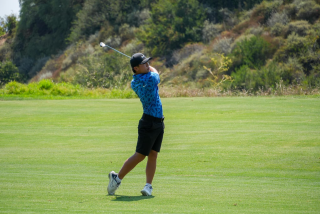The FACTS ON . . . THE GOLF SWING
- Share via
FINDING A PRO:
Virtually every golf course in San Diego County has a professional certified by the Professional Golfers of America to teach. Just call and make an appointment.
CHOOSING A PRO:
Obviously, pros are not all the same, so it’s best to find one who most easily relates to you. Lanny Wadkins has this advice: “You know instruction is good when the pro is working a bit differently with each individual. An instructor can’t teach everybody the same thing. Everyone’s swing is a little different.”
Keep your first lesson short, and therefore inexpensive, until you determine if you like the pro.
COST
The price of lessons depends on the course and whether the lesson is private or with a group. For example, Bonita Golf Club charges $35 for a hour-long private lesson. But an hour group lesson for two costs $17.50 apiece.
Other clubs charge by the half-hour. For instance, the Carlton Oaks Lodge and Country Club in Santee, the Cottonwood Country Club in El Cajon, the Mission Bay Golf Course, the Stardust Country Club in Mission Valley and the Torrey Pines Municipal Golf Course all charge $20 for a half-hour. Singing Hills Country Club in El Cajon charges $18 for a half-hour lesson or $90 for a series of six.
A series of five group lessons at Mission Bay costs $20. A player can take an hour-long group lesson for $5 at Carlton Oaks. Torrey Pines and Stardust offer a series of six private lessons for $100. Torrey Pines does not offer group lessons. Stardust’s rate for two people sharing a lesson is $30 per hour or $15 each.
Bonita, Carlton Oaks and Cottonwood each have two staff teaching professionals. Cottonwood has three or four free-lance instructors. Mission Bay and Torrey Pines have four pros apiece, and Singing Hills has nine staff teachers.
For more information, call the pro shop at the course of your choice.
QUICK TIPS
Golf Magazine this month has a picture of Ben Crenshaw on the cover with a caption, “Chip Like A Pro.” Can anyone really chip like a professional just by reading the story inside? Of course not. But the golf tips keep on coming. Any golf magazine will be loaded with them. Golf Digest’s “Instant Lesson” this month is “Think ‘Triple Left’ For Improved Chipping.” Most televised golf tournaments include a tip or two during lulls in the action.
HANDY HELPERS
You have probably seen, in the back pages of a magazine, those ads that claim: “Help take 10 strokes off your score in two weeks.” Do any of these little aids help? Yes, says Harry McCarthy, 70, former head pro at Balboa Park Golf Course. “They’ve got some that are like sleeves that you can put over your left arm to help keep it straight during your swing,” he said. “That can help quite a bit. They have this other thing that is like handcuffs except they go around both of your elbows. It’s designed to keep your elbows together.” Diane McHeffey, a local pro, tells of a putting aid that forces the player to keep the putter on a straight path during the entire putting stroke. “It’s simply two pieces of plastic that you can adjust to be just wider than the width of your putter. Then you practice your putting stroke hoping not to hit either side of the plastic.”
Of course, you can’t take this out with you on the course, so as helpful as these methods might be, they can only work with a lot of practice.
NEW METHOD
One of the recently developed teaching methods was designed by Bob Poen of San Diego.
The idea of the program, The Ultimate Golf Swing, is to teach the player muscle memory in the swing during one year. Gene Littler, a former PGA pro, speaks for the Poen system on a videotape: “The science of perfect practice is a systematic program of changing bad habits into good habits.”
Poen’s system teaches relaxation techniques and also uses baroque music on its video and audio cassette tapes in order to “help the student learn quicker.”
After one year, Poen says on his video, the player’s golf swing will take care of itself. The idea being that if one practices certain movements of the swing enough, the muscles will automatically move that way.
Lanny Wadkins, a PGA pro, says, “Each player should be taught to swing based on the swing they already have.”
But The Ultimate Golf Swing teaches only one swing.
“But,” Poen says in his tape, “there are some fundamentals you should never violate.”
SWING ANALYZER
Four years ago in Eugene, Ore., club designer Louis Johnson got the idea for Fore-Ward Golf, a company that uses swing analyzers to study the swing and then constructs golf clubs designed specifically for each swing. The company opened a new branch in Clairemont last year.
“It’s definitely for somebody who really wants to put more money and time into golf,” McHeffey said.
The clubs cost $120 for each wood and $85 for each iron. How important can custom-designed clubs be? Wadkins uses the example of Tom Kite, whose club faces are set at different degrees than most other players on the PGA tour. “I was the only one who knew that for a while,” Wadkins said. “So when he’d hit a 5-iron to the green, I’d use a 6-iron. Other players would also use a 5-iron and their balls would fly over the green. They didn’t know his clubs were different.”


